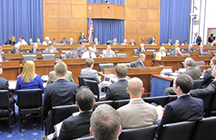 |
 |
|
| eNews • September 2013 | ||
| Promoting a Cost-Effective, Reliable and Competitive Transportation System |
||
 House Committee Passes Water Resources Reform and Development Act (WRRDA)
House Committee Passes Water Resources Reform and Development Act (WRRDA)
On September 19, the House Committee on Transportation and Infrastructure unanimously approved its version of water resources reform legislation. The measure proceeds to the full House of Representatives with an anticipated vote in mid October. The Senate passed its version of the legislation in May.
H.R. 3080, the Water Resources Reform and Development Act of 2013 (WRRDA), was introduced in the House by Transportation and Infrastructure Committee Chairman Bill Shuster (R-PA), Committee Ranking Member Nick J. Rahall, II (D-WV), Water Resources and Environment Subcommittee Chairman Bob Gibbs (R-OH), and Subcommittee Ranking Member Tim Bishop (D-NY).
Through WRRDA, Congress authorizes the U.S. Army Corps of Engineers to carry out its missions to develop, maintain, and support the nation’s vital port and waterways infrastructure needs, and support effective and targeted flood protection and environmental restoration needs. Historically, Congress has passed such legislation every two years to provide clear direction to the Administration and the Corps, but no bill has been signed into law since 2007.
“WRRDA is the most policy and reform focused legislation of its kind in the last two decades,” Shuster said. “This bill contains no earmarks and makes reforms needed to increase transparency, accountability, and Congressional oversight of federal water resources development. At its heart, WRRDA is about jobs and improving America’s competitiveness. A strong water transportation network is critical to keeping pace with other nations that are improving their own infrastructure networks and gaining ground in an increasingly competitive global marketplace.”
“This bill invests in our infrastructure and represents one of the only jobs bills that has been considered in this Congress,” said Rahall. “It boosts our ports, allows commodities to move more efficiently along our inland waterways, and enables our water transportation network to support increased economic opportunity.”
Some of the main provisions of the legislation include:
• The bill would authorize $8 billion in new project construction and $2 billion in modification work. $12 billion worth of projects would be deauthorized.
• Similar to the Senate bill, the House legislation is designed to expedite studies relating to port and inland waterway projects. Environmental reviews can take more than 15 years. Inspired by the Army Corps of Engineers’ “3-3-3” initiative, the bill would require all environmental studies to be finished in three years for under $3 million, and be able to be contained in a three inch binder. The bill would allow Corps local, state and federal employees to conduct the study concurrently.
• The House bill takes a less aggressive approach to reforming the Harbor Maintenance Trust Fund (HMTF). While the Senate bill would give all Harbor Maintenance Taxes — the 0.125 percent levy on the value of imported cargo — back to ports by 2020, the House version would return no less than 80 percent of collected taxes to ports by 2020. Approximately 65 percent of the $1.8 billion in estimated taxes in fiscal 2014 would go back to ports, and the House bill would increase that amount by 2 percent each year. The money not provided to ports for dredging and maintenance would be used for budget offsets. Under the House bill, 10 percent of HMTF spending in fiscal years 2015 and 2016 would go to ports that handle less than a million tons of cargo annually.
• The House bill would also shift the burden to pay for the overbudget and delayed Olmsted lock and dam project. Instead of relying solely on the Inland Waterway Trust Fund (IWTF), the bill would have federal funding pay for 75 percent of the project. The Senate version, however, would put the entire onus on the federal government, freeing up the IWTF for other inland waterway projects.
• The bill calls upon the Secretary of the Army to conduct a study on the impact to the economy and environment of closing the Upper St. Anthony Falls Lock including an annual tonnage assessment. If the five-year average falls below 1.5 million tons, the Corps is directed to close the lock permanently.
Soy Transportation Coalition |
|
